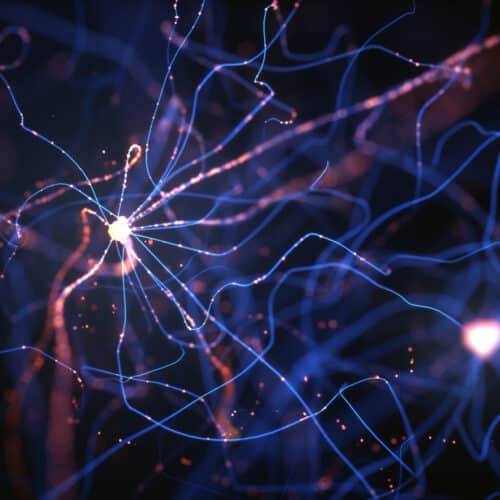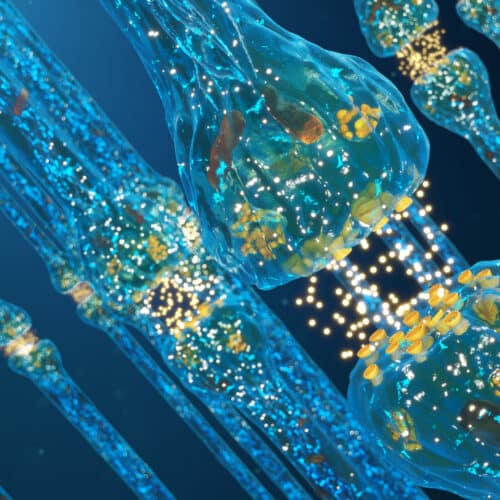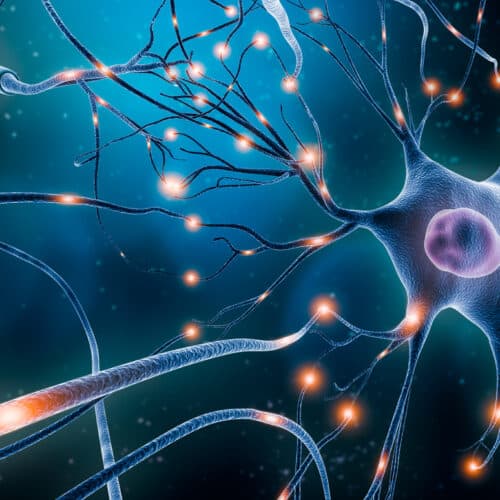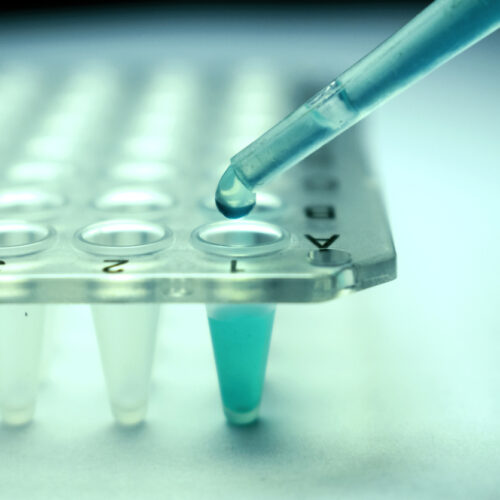Parkinson’s and nerve growth factors

Nerve growth factors, or neurotrophic factors, are proteins that support nerve cells (neurons) by encouraging their growth, development, and survival. There has been considerable research exploring their potential use in Parkinson’s.
How could nerve growth factors help to treat Parkinson’s?
Researchers believe that increasing levels of specific nerve growth factors associated with dopamine neurons could slow Parkinson’s progression. While the translation of nerve growth factor research from the laboratory into a potential treatment for people with Parkinson’s has posed its challenges, there is progress being made by researchers to find solutions. Cure Parkinson’s is actively working to overcome obstacles, and the journey towards a promising treatment is testament to the effort of all those involved. Learn more about the nerve growth factors being explored for Parkinson’s and the research being conducted in these areas below.
GDNF
Glial cell-derived neurotrophic factor (GDNF) is thought to play a role in dopamine neuron differentiation – the process by which cells are instructed what type of neuron to develop into – and survival. There is much laboratory evidence to suggest that increasing levels of GDNF can slow or prevent neuron loss; however, this has yet to be replicated in a clinical trial. Cure Parkinson’s has supported further research into GDNF therapies, including exploring another closely related nerve growth factor, GDF5.
The 2019 Phase 2 Bristol Study
Back in 2019, the results of the Cure Parkinson’s supported phase 2 Bristol study investigating the use of GDNF for people with Parkinson’s were published. While there were some encouraging signs of improvements in those receiving GDNF, there was no significant difference between the active treatment group and those who received the placebo drug in any assessments of Parkinson’s symptoms in the trial.
GDF5
RET receptors are a type of protein which GDNF needs to bind to in order to affect cells. Think of this like texting someone without a phone; they will never receive the message if they don’t have a device to receive them on. There is some evidence to suggest that levels of RET receptors are lower in people with Parkinson’s, which could provide an explanation for why GDNF has not been successful in clinical trials yet.
Cure Parkinson’s is funding a pre-clinical study, led by Professors Aideen Sullivan and Gerard O’Keefe at University College Cork, of the neurotrophic factor glial differentiation factor 5 (GDF5). GDF5 is very closely related to GDNF but is RET-independent, meaning the treatment would not rely on these proteins being present.
How is gene therapy being explored for GDNF?
One of the greatest challenges associated with testing these therapies is their administration. Our brains are surrounded by a protective layer of cells called the blood-brain-barrier, which controls what comes in to and out of the brain. Most nerve growth factors are too large to pass over the blood-brain-barrier, meaning these therapies cannot be taken orally or via injection. Instead, an invasive surgical approach is necessary to allow these proteins to be administered directly to the brain, which needs to be done several times within one trial.
Researchers are exploring different ways to overcome this challenge, one being gene therapy. Gene therapy uses modified, inactive forms of viruses to direct cell activity. In this case, researchers are hoping to use this to tell neurons to increase production of neurotrophic factors, like GDNF. This method would only require a one-time surgery and the effects of this treatment could potentially be longer as cells would be able to produce their own GDNF.
REGENERATE-PD
As of December 2024, AskBio has opened recruitment for their phase 2 trial of AB-1005 called “REGENERATE-PD”, which aims to assess the safety and efficacy of AB-1005 in people with Parkinson’s. This trial will be recruiting in both the US and UK.
Watch Professor Alan Whone, one of the principal investigators on REGENERATE-PD, talk about the trial at the Rallying 2024 meeting: https://youtu.be/BAWp-xlqlXM?si=y1iJCqSE0gaQAfLF .
CDNF
Cure Parkinson’s has also supported work looking at another nerve growth factor for the treatment of Parkinson’s: cerebral dopamine neurotrophic factor (CDNF). More specifically, researchers in Finland have been developing a small fragment version of CDNF, called C-CDNF, that would be able to pass through the blood-brain-barrier. If effective in the laboratory, C-CDNF could eliminate the need for surgery, making it a more accessible treatment for people with Parkinson’s.
HER 096
Another small fragment version of CDNF, called HER-096, is currently in a phase 1b clinical trial for Parkinson’s. The Finland-based company Herantis Pharma completed their phase 1a clinical trial of ‘HER-096’ in late 2023. In topline results, the company announced that the trial met its primary and secondary outcomes, indicating the treatment was safe and tolerable when taken by healthy volunteers, as well as showing evidence of reaching the brain.
The company began recruiting for a phase 1b clinical trial of HER-096 in late 2024. This trial aims to assess its safety and tolerability in a population of people with Parkinson’s.

Neurotrophic factors for Parkinson’s: insights from a previous workshop
In 2023, Cure Parkinson’s hosted a workshop where leading experts reviewed the potential of neurotrophic factors as a treatment for Parkinson’s disease. A commentary paper summarising the key outcomes…

Latest updates in the field of neurotrophic factors in Parkinson’s
Neurotrophic factors such as GDNF are still being actively investigated as a potential treatment for Parkinson’s, and alternative methods of delivery are currently being explored.

New data supporting neurotrophic factor as a potential treatment for Parkinson’s
An article in the Journal of the International Movement Disorders Society reports on some pre-clinical (laboratory) data supporting the development of ‘Glial cell line-Derived Neurotrophic Factor’ (GDNF) as a…

Phase 1 trial results of new GDNF delivery mechanism
The results of a recent clinical trial testing a new way of delivering the nerve growth factor, GDNF, into the brains of people with Parkinson’s demonstrate that it is…

Neurotrophic Factor GDF5 – an alternative to GDNF?
Neurotrophic factors are small protein that are naturally produced in the brain to help nurture and protect nerve cells (neurons). Cure Parkinson’s is a strong supporter of research…

Cure Parkinson’s funds new nerve growth factors for Parkinson’s
Nerve growth or neurotrophic factors such as CDNF and GDNF are proteins that support neurons and encourage their growth and survival during development. There has been considerable preclinical research…

Documentary: ‘The Parkinson’s Drug Trial: A Miracle Cure?’
This award winning documentary was first broadcast in 2019 and features trial participants, including our late co-founder Tom Isaacs, in a cutting-edge drug trial involving complex brain surgery; and…

GDNF – A new chapter
We welcome the news of further investment in GDNF (Glial Cell-Line Derived Neurotrophic Factor) by Parkinson’s UK.

‘AskBio’ acquires BNB and GDNF gene therapy trials
BNB and AskBio have joined forces to expand a gene therapy programme for Parkinson’s

Herantis Pharma: Phase 1/2 CDNF topline results
We are delighted that Finnish-based Herantis Pharma Plc have announced that their ongoing phase 1-2 clinical trial testing the neuroprotective agent ‘cerebral dopamine neurotrophic factor’ (or CDNF) in people…

GDNF and cell transplantation: dual therapies for Parkinson’s
Parkinson’s is a complex condition and it is becoming increasingly clear that the future of disease-modifying therapies for Parkinson’s will rely on the use of multiple treatment approaches, as…

GDNF trial results published
Results from a pioneering clinical trials programme that delivered an experimental treatment directly into the brain of people with Parkinson’s offer hope that it may be possible to restore…
